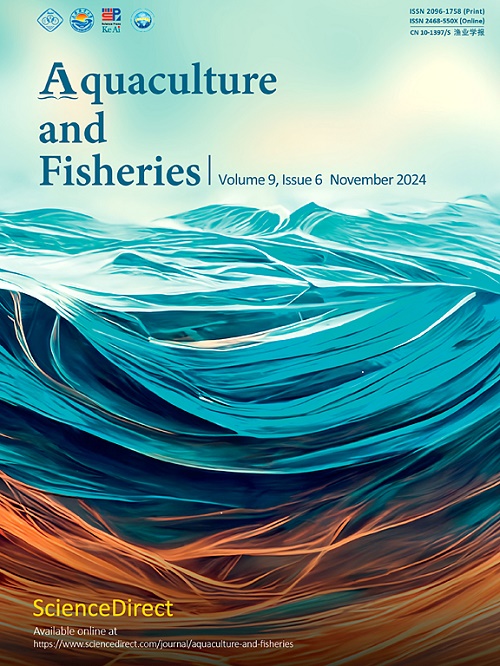饲粮中添加藜草和总状芦笋可通过转录调控马尾松鱼的生长和免疫应答基因提高其生长性能
Q1 Agricultural and Biological Sciences
引用次数: 0
摘要
在长达60天的试验中,对两种中草药饲料添加物——粗花菊和总状芦笋单独和组合对硬骨鱼马尾鱼生长的改善潜力进行了评估。15天实验室驯化鱼(14±1)g;(11±1)cm,根据饲粮添加剂的组成,随机分为C(对照组)、S1、S2、S3、A1、A2、A3、AS1、AS2和AS3组。每组10只(n = 10),实验一组重复。60 d后,除S1组外,其余各组的末重均显著升高;30 d和60 d后,除S1组外,其余各组的增重率均显著升高(P <显著水平);0.05. 相比之下,饲料系数(FCR)显著(P <;除S1外,各试验组在60 d后均较对照组降低。肝体指数(HSI %)显著降低(P <;0.05), S3、A2、A3、AS1、AS2、AS3组均升高;而脏器指数(VSI %)也显著(P <;0.05), A3组、AS1组、AS2组和AS3组与c组比较显著(P <;0.05)胰蛋白酶和凝乳胰蛋白酶活性的升高,在两个采样时间后进行记录;AS3期最高,60 d后分别为3.47倍和2.06倍,说明蛋白质消化率较高。qRT-PCR分析显示,肝脏和肌肉组织中生长相关基因gh、igf-1和igf-2a均上调。此外,在AS3中,gh在肝脏组织的转录水平表达(4.86)倍高于肌肉组织(4.43)倍;而igf-1和igf-2a显著(P <;0.05)在AS2和AS3肌肉中表达上调,进一步,显著(P <;0.05),与C组相比,AS1、AS2和AS3组肝脏组织中转化生长因子-β (tgf-β)表达增加,提示联合膳食补充具有免疫保护作用。该研究设想,在饲料中添加3%的这两种草药(AS3)足以影响鱼的消化酶活性、生长指数以及生长相关基因和免疫保护基因的mRNA水平。因此,该研究在水产养殖中发现了充足的应用空间。本文章由计算机程序翻译,如有差异,请以英文原文为准。

Dietary supplementation of Withania somnifera and Asparagus racemosus enhances growth performance coupled with transcriptional modulation of growth and immune responsive genes in fish, Channa punctatus
The growth amelioration potential of two herbal feed supplements, Withania somnifera and Asparagus racemosus, individually and in combination, was evaluated up to 60 days of feeding trial in a teleost, Channa punctatus. 15 days laboratory acclimatized fish (14 1) g; (11 1) cm were randomly distributed in 10 groups- C (control), S1, S2, S3, A1, A2, A3, AS1, AS2, and AS3, based on the composition of the dietary supplements. Each group had 10 specimens (n = 10), and the experiment was performed in triplicate. Elevated final body weight (FBW) was observed in all groups except S1 after 60 days, and weight gain percentage (WG %) showed a significant increase in all groups except S1 after both 30 and 60 days of the sampling periods with a significance level of P < 0.05. In contrast, the feed conversion ratio (FCR) significantly (P < 0.05) decreased in all experimental groups, except S1, as compared to the control, after 60 days of sampling duration. The hepatosomatic index (HSI %) significantly (P < 0.05) increased in groups - S3, A2, A3, AS1, AS2, and AS3; while the viscerosomatic index (VSI %) also significantly (P < 0.05) enhanced in groups - A3, AS1, AS2, and AS3 as compared to C. Significant (P < 0.05) elevations in activities of both trypsin and chymotrypsin, after both the sampling durations were recorded; the maximum being in AS3 as 3.47 and 2.06-fold, respectively, after 60 days, suggests greater protein digestibility. The qRT-PCR analysis displays an up-regulation of growth-related genes-gh, igf-1, and igf-2a, both in the liver and muscle tissues. Also, gh showed greater expression at transcriptional levels in liver tissues (4.86)-fold than muscle tissues (4.43)-fold in AS3; whereas igf-1 and igf-2a were significantly (P < 0.05) upregulated in the muscles of AS2 and AS3 as compared to C. Further, significantly (P < 0.05) increased expression of the transforming growth factor-β (tgf-β) in liver tissues was recorded in groups- AS1, AS2, and AS3, as compared to C, suggesting the immunoprotective role of combined dietary supplements. The study envisages that 3% dietary supplementation with both herbs (AS3) sufficiently influences the activities of digestive enzymes, growth indices, and mRNA levels of growth-related and immunoprotective genes in the fish. The study thus finds ample scope in aquaculture.
求助全文
通过发布文献求助,成功后即可免费获取论文全文。
去求助
来源期刊

Aquaculture and Fisheries
Agricultural and Biological Sciences-Aquatic Science
CiteScore
7.50
自引率
0.00%
发文量
54
审稿时长
48 days
期刊介绍:
 求助内容:
求助内容: 应助结果提醒方式:
应助结果提醒方式:


